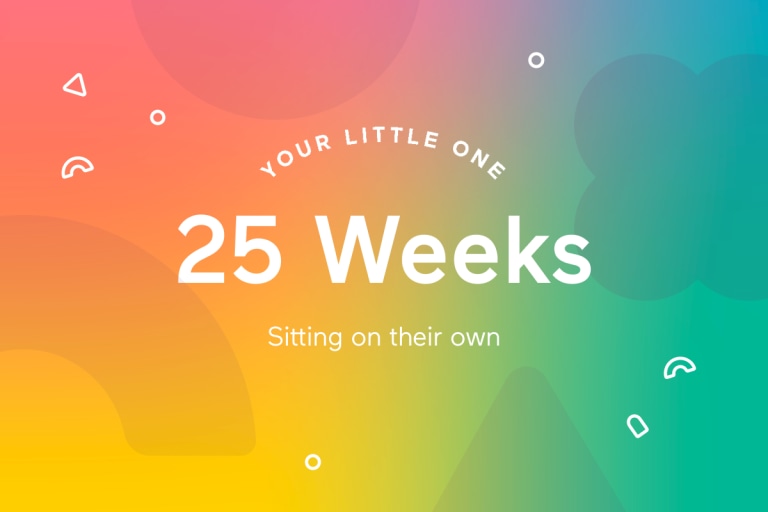
Your 25-Week-Old Baby
Sitting on top of the world (well, technically, the playmat)

By Babylist Staff
Milestone: Sitting Up
Some babies show the beginning signs of sitting as early as four months, while others ease their way into sitting on their own around seven or eight months. The first sign your baby is gearing up? Good head control. Your baby must be able to hold their noggin up before moving into this next milestone.
Sitting is a gradual process. As babies master sitting, they may only be able to do it for a few seconds at a time. Then they’ll slowly build the strength and endurance for longer durations. They’ll need lots of support until they get the hang of this newfound skill.
Allow them to sit upright on your lap as often as you can. When you seat your baby on the floor, place them on a soft surface like carpet or a cushioned activity mat. Be sure to stay close by to swoop in during those inevitable topples. Never let your baby sit unattended on a couch or bed.
Playing with toys becomes even more fun in a seated position, thanks to the cool new view. Many parents consider this stage the sweet spot—babies are engaged with objects in front of them but aren’t yet on the move. So, plop down on the playmat and relax while you can…because crawling is coming your way next!
When Should Babies Stop Using Pacifiers?
By this age, you probably know if your baby likes a pacifier or not. Lots of babies—and their parents—love binkies. They can help soothe babies when they’re fussy, assist them in falling asleep at night and might help reduce the risk of SIDS. But as babies get older, many parents wonder if it’s OK for baby to keep using one.
The American Academy of Pediatric Dentistry says the use of pacifiers and thumb or finger sucking is normal, and that most children stop using pacifiers, either on their own or with some parental intervention. So if your baby loves to suck, don’t stress about it at this stage. Try not to pop one in at any sign of fussing, though, and be sure to use an age-appropriate orthodontic pacifier and clean them often. Note: there have been studies that suggest pacifier use might increase the risk of middle ear infections, so if your litle develops them down the line, be sure to tell your pediatrician about any paci use.
Diaper Changes and Squirmy Babies
When your baby begins to roll and sit up, you might find that changing them becomes a (sometimes very messy) challenge. You want to keep squirmy, wiggly babies safe and avoid getting whatever’s in that diaper from getting all over.
Here are some tips for making diaper changes easier as baby gets more mobile:
Distractions are key. Keep small toys, books or teethers close by to give to your baby when you put them on the changing table. Crinkly textures, fun sounds and shiny colors can get their attention. Try to rotate through different toys, as one might not keep them interested long enough for you to get the job done. Singing, pointing out body parts and tickling while you’re changing them can also keep them entertained.
Change it up. If you find that baby won’t stay on the changing table or starts to know it means it’s time for a diaper change and gets upset, a change of scenery can do you both good. Move to the floor, a bed or the couch—just lay a blanket, large burp cloth or towel down in case of accidents.
Keep your supplies close. Have your diapers (keep multiple at the ready in case something happens to the first one), wipes, diaper rash cream and whatever else you might need near you so you can work quickly and keep one hand on your squirmer while you’re grabbing the next thing.
Fun Stuff: Best Activity Centers
Peace out, recliners! Around six months old is prime time to add an activity center into your playtime repertoire. Babies have a blast swiveling around in the built-in chair, surrounded by the attached colorful (and sometimes noisy!) gadgets and gizmos. Activity centers give hand-eye coordination a boost (that “pincer grasp” is about to get really good!) and keep your little explorer happy and busy.
Good news: you don’t have to retire the table once your baby is on the move. When your little one gets more mobile, they’ll be able to cruise around the outside for a fresh perspective of those beloved toys. Better yet, some activity centers are designed to grow with your kiddo by converting into toddler-sized tables, perfect for arts and crafts, block building and snack-time. Check out Babylist parents’ favorite activity centers.